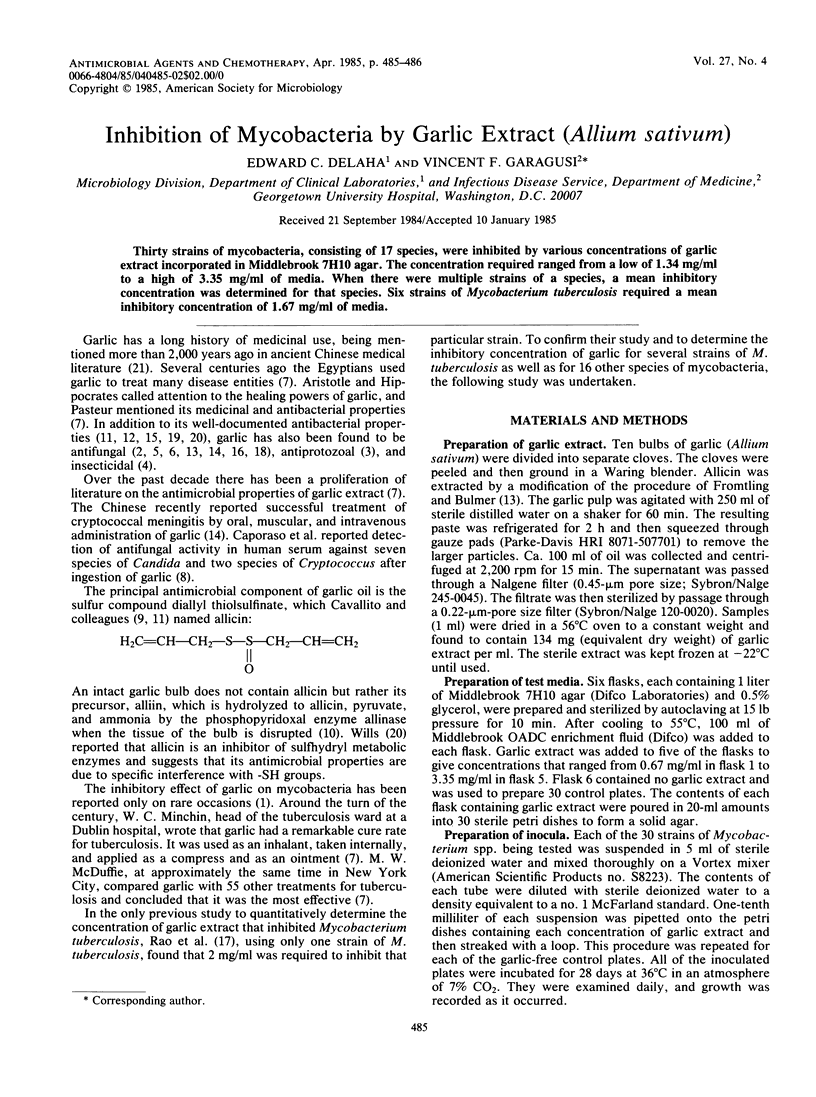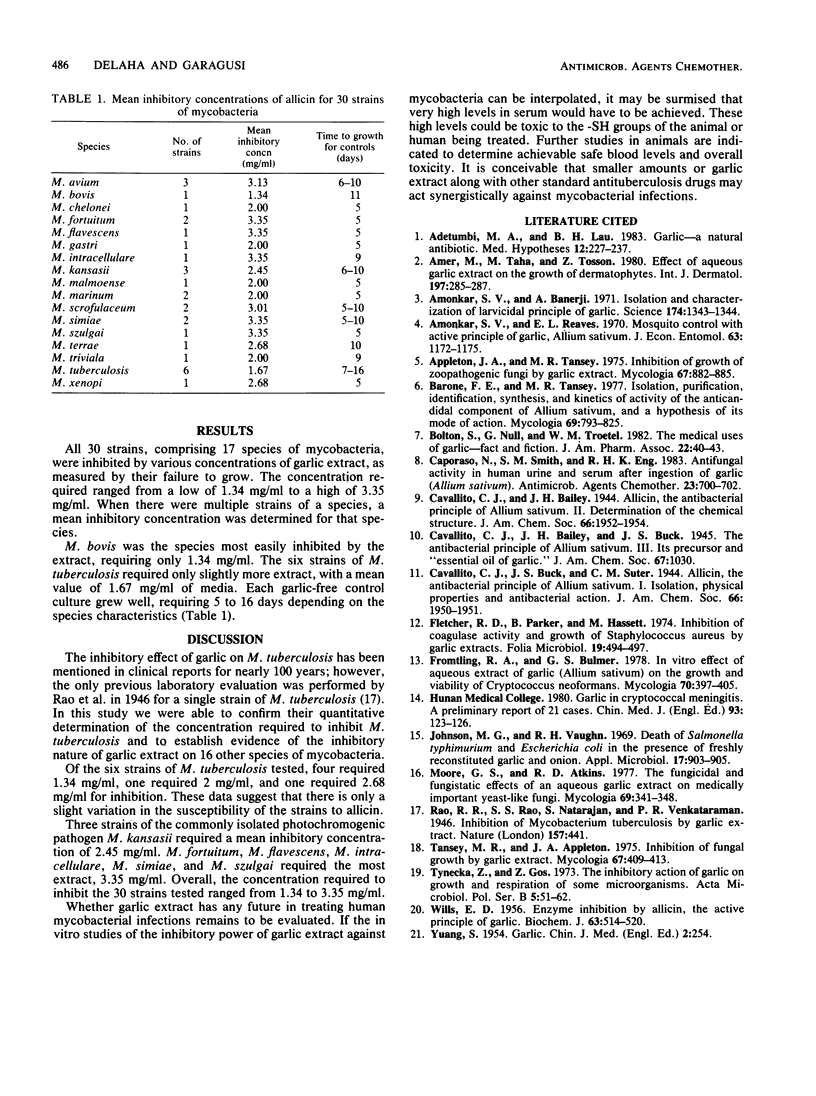Abstract
Thirty strains of mycobacteria, consisting of 17 species, were inhibited by various concentrations of garlic extract incorporated in Middlebrook 7H10 agar. The concentration required ranged from a low of 1.34 mg/ml to a high of 3.35 mg/ml of media. When there were multiple strains of a species, a mean inhibitory concentration was determined for that species. Six strains of Mycobacterium tuberculosis required a mean inhibitory concentration of 1.67 mg/ml of media.
Full text
PDF

Selected References
These references are in PubMed. This may not be the complete list of references from this article.
- Adetumbi M. A., Lau B. H. Allium sativum (garlic)--a natural antibiotic. Med Hypotheses. 1983 Nov;12(3):227–237. doi: 10.1016/0306-9877(83)90040-3. [DOI] [PubMed] [Google Scholar]
- Amer M., Taha M., Tosson Z. The effect of aqueous garlic extract on the growth of dermatophytes. Int J Dermatol. 1980 Jun;19(5):285–287. doi: 10.1111/j.1365-4362.1980.tb00331.x. [DOI] [PubMed] [Google Scholar]
- Amonkar S. V., Banerji A. Isolation and characterization of larvicidal principle of garlic. Science. 1971 Dec 24;174(4016):1343–1344. doi: 10.1126/science.174.4016.1343. [DOI] [PubMed] [Google Scholar]
- Amonkar S. V., Reeves E. L. Mosquito control with active principle of garlic, Allium sativum. J Econ Entomol. 1970 Aug;63(4):1172–1175. doi: 10.1093/jee/63.4.1172. [DOI] [PubMed] [Google Scholar]
- Appleton J. A., Tansey M. R. Inhibition of growth of zoopathogenic fungi by garlic extract. Mycologia. 1975 Jul-Aug;67(4):882–885. [PubMed] [Google Scholar]
- Barone F. E., Tansey M. R. Isolation, purification, identification, synthesis, and kinetics of activity of the anticandidal component of Allium sativum, and a hypothesis for its mode of action. Mycologia. 1977 Jul-Aug;69(4):793–825. [PubMed] [Google Scholar]
- Bolton S., Null G., Troetel W. M. The medical uses of garlic--fact and fiction. Am Pharm. 1982 Aug;NS22(8):40–43. doi: 10.1016/s0160-3450(16)31735-4. [DOI] [PubMed] [Google Scholar]
- Caporaso N., Smith S. M., Eng R. H. Antifungal activity in human urine and serum after ingestion of garlic (Allium sativum). Antimicrob Agents Chemother. 1983 May;23(5):700–702. doi: 10.1128/aac.23.5.700. [DOI] [PMC free article] [PubMed] [Google Scholar]
- Fletcher R. D., Parker B., Hassett M. Inhibition of coagulase activity and growth of Staphylococcus aureus by garlic extracts. Folia Microbiol (Praha) 1974;19(6):494–497. doi: 10.1007/BF02872915. [DOI] [PubMed] [Google Scholar]
- Fromtling R. A., Bulmer G. S. In vitro effect of aqueous extract of garlic (Allium sativum) on the growth and viability of Cryptococcus neoformans. Mycologia. 1978 Mar-Apr;70(2):397–405. [PubMed] [Google Scholar]
- Johnson M. G., Vaughn R. H. Death of Salmonella typhimurium and Escherichia coli in the presence of freshly reconstituted dehydrated garlic and onion. Appl Microbiol. 1969 Jun;17(6):903–905. doi: 10.1128/am.17.6.903-905.1969. [DOI] [PMC free article] [PubMed] [Google Scholar]
- Moore G. S., Atkins R. D. The fungicidal and fungistatic effects of an aqueous garlic extract on medically important yeast-like fungi. Mycologia. 1977 Mar-Apr;69(2):341–348. [PubMed] [Google Scholar]
- Tansey M. R., Appleton J. A. Inhibition of fungal growth by garlic extract. Mycologia. 1975 Mar-Apr;67(2):409–413. [PubMed] [Google Scholar]
- Tynecka Z., Goś Z. The inhibitory action of garlic (Allium sativum L.) on growth and respiration of some microorganisms. Acta Microbiol Pol B. 1973;5(1):51–62. [PubMed] [Google Scholar]
- WILLS E. D. Enzyme inhibition by allicin, the active principle of garlic. Biochem J. 1956 Jul;63(3):514–520. doi: 10.1042/bj0630514. [DOI] [PMC free article] [PubMed] [Google Scholar]


